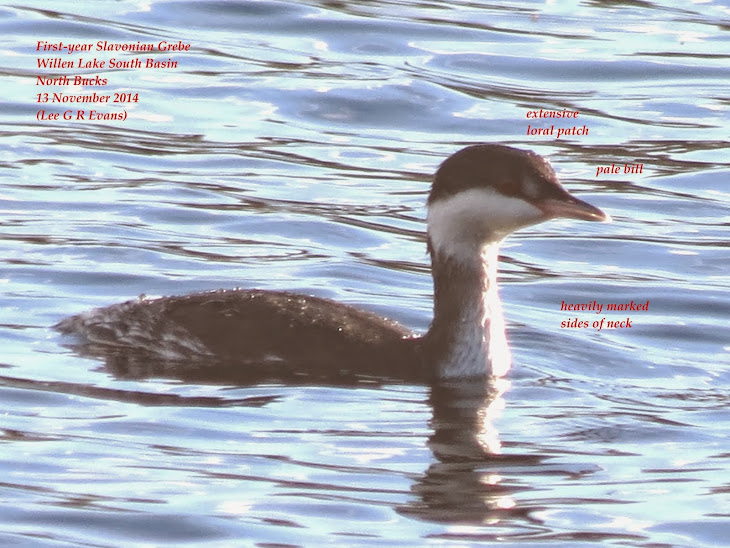SATURDAY 14 NOVEMBERA very deep area of low pressure passed over the area today bringing near gale force SSW winds and more heavy rain, occasionally torrential. There was little respite from the conditions all day and mid afternoon saw the arrival of a windswept juvenile GREAT NORTHERN DIVER at Calvert BBOWT
CHESS RIVER VALLEYThankfully the juvenile
OSPREY survived the conditions and was seen several times this afternoon, flying between the Pumping Station and Chenies Bottom. It was not seen to successfully fish however.
The adult male
BLACK REDSTART also remains at Valley Farm, with a male
COMMON STONECHAT in the paddocks thereabouts.
Five LITTLE EGRETS remain in the area.
TRING RESERVOIRSDavid Bilcock discovered an adult winter
BLACK-NECKED GREBE early morning, the first record there this year. I rolled up at Wilstone at 1045 hours and dodging the heavy showers and braving the gusty wind, managed to relocate the bird, diving frequently just offshore of the central bund. It was sheltering from the wind in the small bay just east of the Drayton Bank but later moved much closer to the jetty and was still present when I left early afternoon. Roy, Mike Campbell and Charlie Jackson had all seen it before I arrived.
Also on
WILSTONE RESERVOIR
Great Crested Grebe (14)
Little Grebe (2)
Mute Swan (35 including 7 first-winters)
Greylag Geese (4)
Common Teal (198 including 101 in the SE quadrant)
Gadwall (19)
Eurasian Wigeon (256)
Shoveler (87)
NORTHERN PINTAIL (single female feeding by the old boathouse inlet)
Tufted Duck (117)
Pochard (14)
*
PEREGRINE (single scattering the plover flock on several occasions eventually drifting off north)
Coot (529+ including 324 in one feeding flock near the hide)
Lapwing (212)
EUROPEAN GOLDEN PLOVER (502)
Common Snipe (8)
Herring Gull (2 first-winters on bund)
Meadow Pipits (14 on the mud)
Dave Bilcock and Steve Rodwell did the late afternoon gull roost and discovered a 'new' 2nd-winter
MEDITERRANEAN GULL (see image above) and 2 Herring Gulls.
STARTOP'S END RESERVOIRWater level has risen dramatically with the 'mud' in the SW corner attracting large numbers of feeding wildfowl including 7 Mute Swans (2 additional adults on Tringford), 57 Greylag Geese, 61 Mallard and 31 Common Teal.
On the main reservoir were 2 Little Grebes, 6 Gadwall, 33 Tufted Ducks, 16 Pochard and 127 Coot.
A Goldcrest was in ivy close to the road bend.
COLLEGE LAKE BBOWT
Little Grebe (1)
Mute Swans (39 present including 3 first-winters)
Mallard x Red-crested Pochard hybrid
Gadwall (36)
Eurasian Wigeon (38)
Shoveler (1 drake)
Pochard (14)
Tufted Duck (27)
*
RUDDY DUCK (2 female-types)
CALVERT BBOWTTook a call from Warren Claydon at around 1430 hours; he had just located a
GREAT NORTHERN DIVER on the main BBOWT Lake at Calvert. Frustratingly I was 43 miles away by that time but with two hours of light left, I decided to give it a go.
It was about 1515 hours when I arrived and Warren, Tim Watts and local birder Colin Oreton were still watching the bird from the Second Hide. It was showing very well, perhaps at 100 yards, and was a juvenile, with characteristic pale barring and pale edgings on the mantle and back. It was gleaming white on the breast with much blacker feathering on the hindneck, nape and crown and had the typical 'bump' on the crown preceding the steep forehead. It had a thick neck with a large pale grey bill. The dark feathering at the base of the neck characteristically formed a half collar.
It was surprisingly on view for much of the time, diving fairly infrequently, but did then become more active and moved back towards the back of the lake. It remained until dusk.
There was a large gull roost on the BBOWT, including at least 1,839 Black-headed Gulls, just 3 Common Gulls, 139+ Herring Gulls (including a predominate number of argenteus adults), at least 9
YELLOW-LEGGED GULLS (5 adults, 2 2nd-winters and 2 first-winters), 700+ Lesser Black-backed Gulls and just 5 Great Black-backed Gulls.
GREAT NORTHERN DIVERS IN BUCKINGHAMSHIREThe species is a rare visitor to the county with just 15 previous records, mostly between November and January. Todays bird represents the fourth for Calvert.
1) The first record involved a bird in the Ford area on 3 December 1774;
2) A juvenile was captured alive in a ditch at Chequers Court on 9 May 1850;
3) One was apparently seen in Chesham in November or December 1859;
4) One was 'obtained' on the River Thames at Marlow in November or December 1865;
5) One was obtained at Temple Island near Henley-on-Thames in 1865;
6) A juvenile was shot at Calvert Brick Pits on 11 November 1944;
7) A juvenile crash-landed in a field adjacent to Foxcote Reservoir on 4 November 1964. It was taken into care and later released but was found dead two days later;
8) One was at Iver GP on 17 January 1965;
9) One was found dead near Willen village in February 1971;
10) A juvenile appeared at Linford GP on 12 November 1972;
11) After a 14-year gap, a juvenile was present at Taplow Fishing Lake from 12 December 1986 until 11 January 1987 (photographed by Mike Wallen and published on page 18 of the 1986 BBR);
12) One was found at Willen Lake on the South Basin during the gull roost vigil on 16 December 1994. It was present for just the first half hour of daylight on 17 December;
13) An adult moulting out of breeding plumage visited Calvert Sailing Lake on 27-28 November 1997 but flew off west when visibility improved on its second day;
14) A juvenile remained present at Caldecotte Lake from 23 December 1997 until 6 January 1998;
15) A juvenile was found late afternoon on Calvert Sailing Lake on 28 November 2006. It was present for just a short time the next morning before flying off east.
Lee G R Evans







